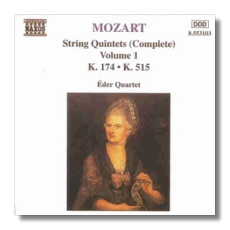
The Internet's Premier Classical Music Source
Related Links
- Mozart Reviews
- Latest Reviews
- More Reviews
-
By Composer
-
Collections
DVD & Blu-ray
Books
Concert Reviews
Articles/Interviews
Software
Audio
Search Amazon
Recommended Links
Site News
 CD Review
CD Review
Wolfgang Mozart

String Quintets, Volume 1
- String Quintet #1 in B Flat Major K. 174 (1787)
- String Quintet #2 in C Major K. 515 (1787)
Éder Quartet
János Fehérávi, viola
Naxos 8.553103 1994 DDD 66:45
What's the only thing worse than a viola? Two violas. Be that as it may, most composers, including Haydn, Mozart, Beethoven, and Schubert, all happily took their turns on the inside of the textures they created. There's an answer to quash all viola tales past, present, and yet to be spun. Besides, two violas can't be all bad, because that's how Mozart chose to broaden the string texture that Franz Joseph Haydn had canonized as the standard one for presenting four voices with elegant economy. And Mozart was apparently a sincere champion of the viola. The hoarse voice of the first viola several times sings the first movement's striking principal theme in Mozart's Quintet in B Flat Major, K. 174. And the second viola doesn't just broaden the texture, it augments it exponentially. Rushing scale passages in these quintets assume the frothy character of rapids in a turbulent stream, and there are enough instruments left over to accompany quiet dialogues a close approximation to concerto grosso compositional technique.
Even the earliest of the quintets takes advantage of all the opportunities the second viola presents (although the early discarded trio of the minuet and the discarded finale, too, both of which are presented on the disc, show that Mozart was mastering the form and technique as he wrote). But the Quintet in C Major, K. 515, is one of the glories of string literature. Darker and richer than most works in C Major, it is among the most strikingly expressive of Mozart's later works. Those who think of Mozart as an overly facile creator of super-slick glazes can't have heard the late string quintets.
The Éder Quartet and additional violist János Fehérávi give creditable accounts of themselves in this important literature. They were recorded in the Unitarian Church in Budapest, where Naxos has made other recordings. But none of them sound just like this one, which places the listener in the same room with the ensemble, with all the advantages and disadvantages of such close quarters. Of course, that's the way this music is heard by its performers much of the time. On the other hand, the claustrophobic will want more "personal space." The effect is undeniably a powerful one, and a stimulating one, too: at any moment, you can aurally prise out any strand from the texture.
The quintets may have received more subtle readings from other ensembles, but in this splendid sonic ambiance, Naxos' performers are hard to resist. So is Mozart, especially in these quintets. And, at Naxos' price, there's no reason to offer resistance. Highly recommended.
Copyright © 1996, Robert Maxham


















